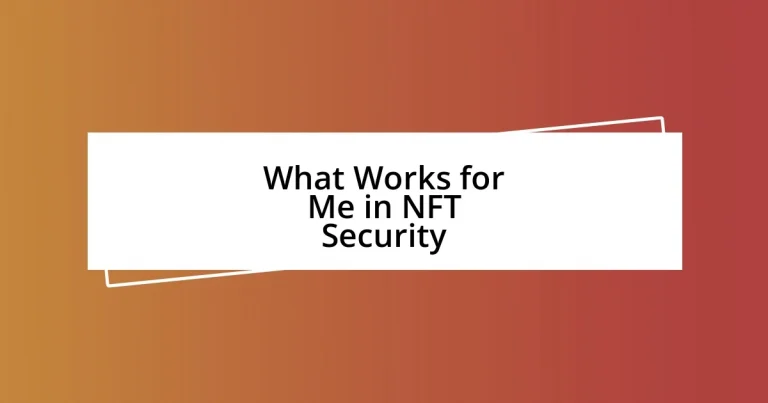Key takeaways:
- Securing private keys and using reputable marketplaces are crucial for NFT security; research is essential to avoid scams.
- Implementing multi-factor authentication (MFA) and using hardware wallets significantly enhances asset protection.
- Regularly review and update security practices, including passwords and backup processes, to maintain robust NFT security.
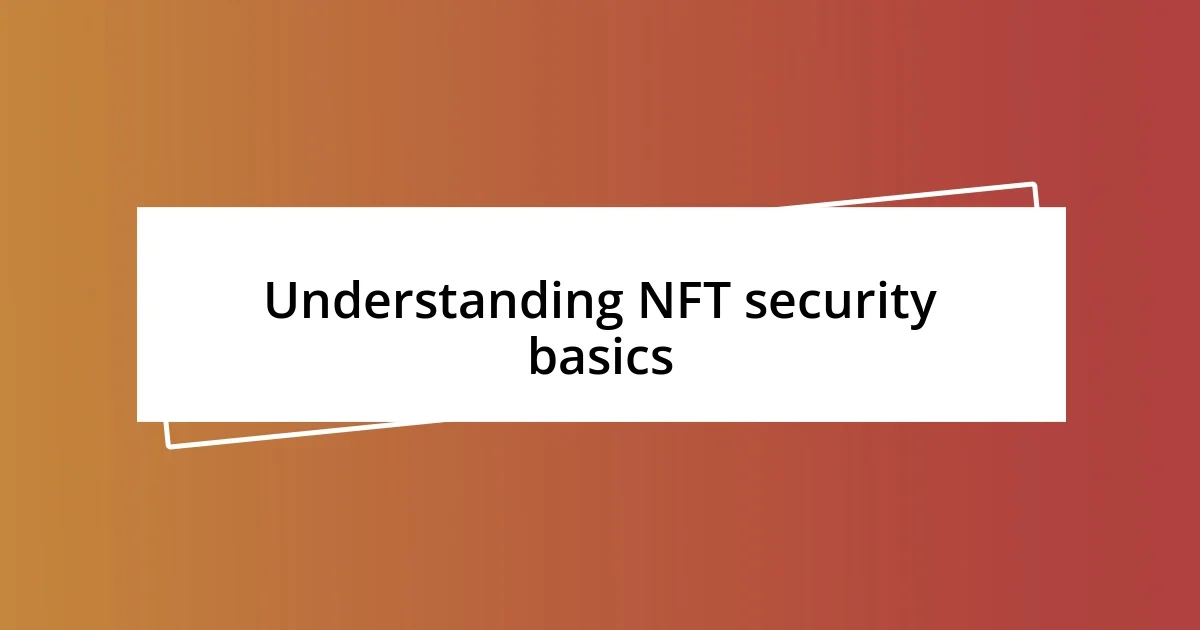
Understanding NFT security basics
When diving into NFT security, it’s essential to grasp the concept of private keys. I remember the first time I experienced the panic of almost losing access to my digital assets because I had misplaced a private key. That moment was a wake-up call; securing your keys is non-negotiable, as they grant you access to your NFTs and any related platforms.
Another critical aspect is the importance of choosing reputable marketplaces. I’ve seen people rush into transactions on lesser-known sites, only to become victims of scams or fraud. It’s a reminder to always conduct thorough research and stick to trusted platforms—after all, would you leave the front door to your home wide open for strangers?
Lastly, I can’t stress enough the value of multi-factor authentication (MFA). Implementing MFA significantly boosts your security, protecting your accounts even if your password is compromised. I often think of it as locking my front door while also installing a solid deadbolt. Why not take every possible precaution when the stakes can be so high?
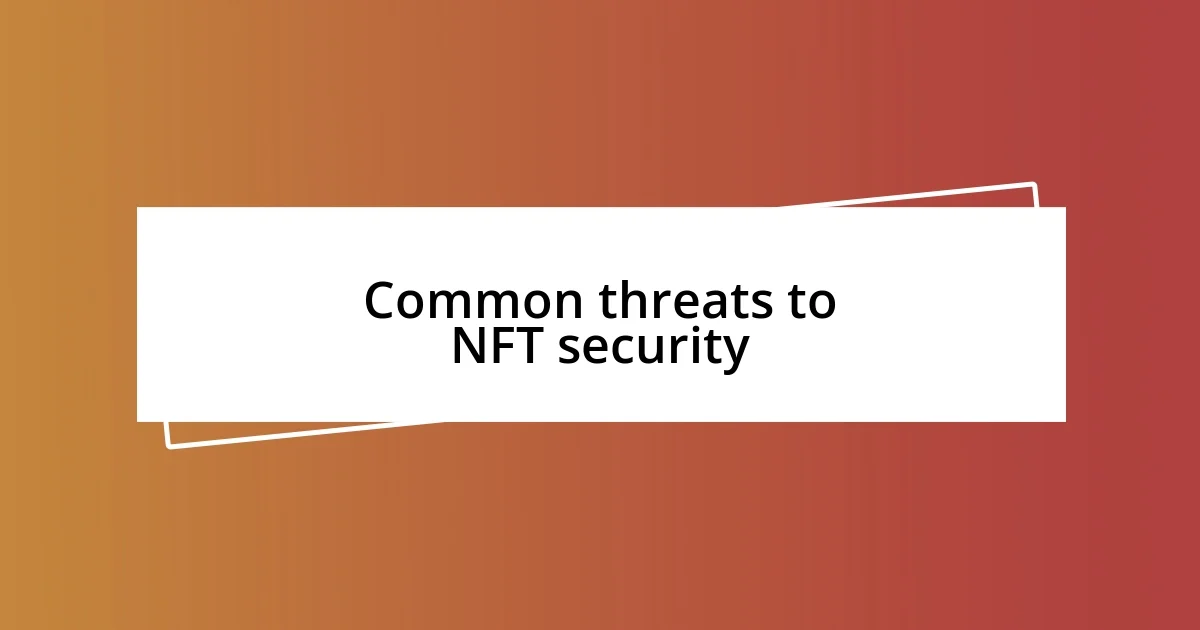
Common threats to NFT security
When considering common threats to NFT security, one significant issue I’ve encountered is phishing attacks. These deceptive practices often caught me off guard, particularly when I received fake emails that appeared to be from legitimate platforms. It’s such a disconcerting feeling to realize how easily someone can manipulate the situation; always verify the sender’s credentials and look for suspicious links.
Another prevalent threat is the risk associated with smart contract vulnerabilities. I remember diving into a project where an exploit was used to drain funds from an NFT marketplace. The unsettling reality is that even minor bugs in code can lead to catastrophic losses for users. So, it’s crucial to understand that not all projects conduct thorough audits, and due diligence is the best defense.
Lastly, I must highlight the dangers of inadequate wallet security. I learned this the hard way when my wallet was compromised because I overlooked enabling security features. The shock of realizing I had lost valuable assets was heart-wrenching. Always prioritize securing your wallets with strong passwords and hardware solutions whenever possible.
| Threat | Description |
|---|---|
| Phishing Attacks | Deceptive emails and links designed to steal private information. |
| Smart Contract Vulnerabilities | Exploits in the code that can compromise funds and NFT security. |
| Inadequate Wallet Security | Weak password protection and lacking multi-factor authentication can lead to asset loss. |
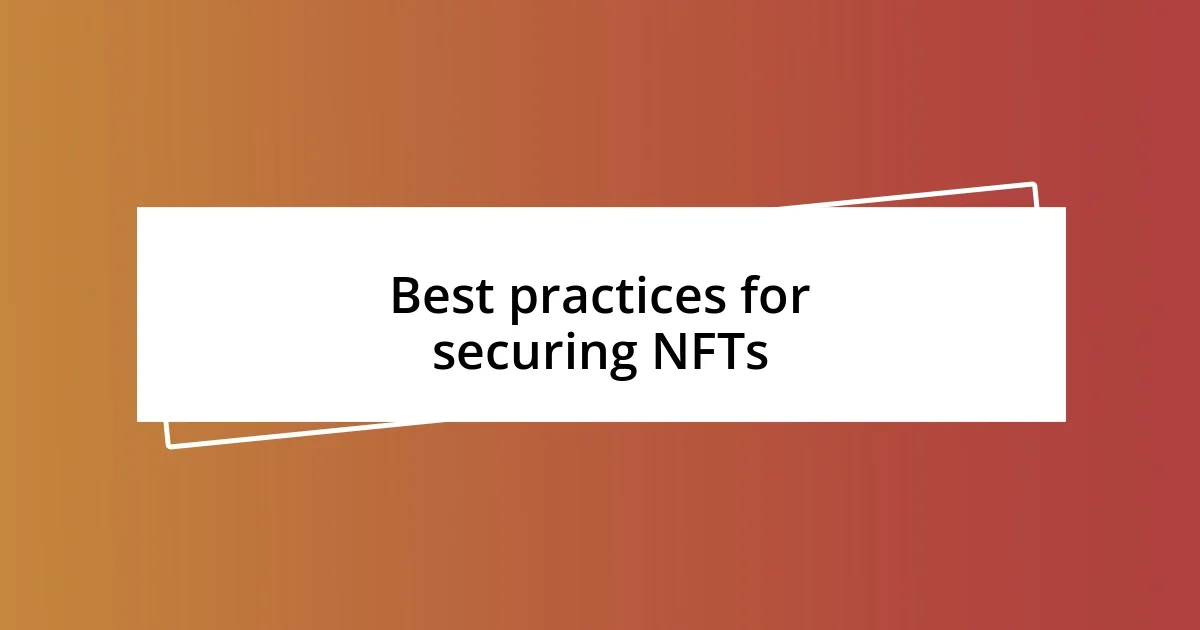
Best practices for securing NFTs
Securing your NFTs isn’t just about technology; it’s also about mindset. I’ve learned to treat my digital assets much like cherished physical belongings. For instance, just as you wouldn’t leave valuable items exposed in public, ensure your NFTs are stored safely in a secure wallet. I’ve found that using a hardware wallet is like having a safe deposit box for my assets; it gives me peace of mind knowing that they’re much less susceptible to online threats.
- Use hardware wallets for long-term storage.
- Regularly update your software and firmware.
- Create strong, unique passwords and change them periodically.
- Be cautious about sharing your screen or discussing your NFTs in public forums.
- Stay informed about the latest threats and security practices in the NFT community.
In addition to these practices, I’ve found the importance of keeping backups of everything crucial. There was a time I lost access to a wallet due to an unexpected device failure. It was an experience filled with dread and regret. Now, I diligently keep multiple backups—both digital and physical—of my private keys and recovery phrases to ensure I never find myself in that vulnerability again. Having these backups in a secure location acts like a safety net, allowing me to breathe a little easier.
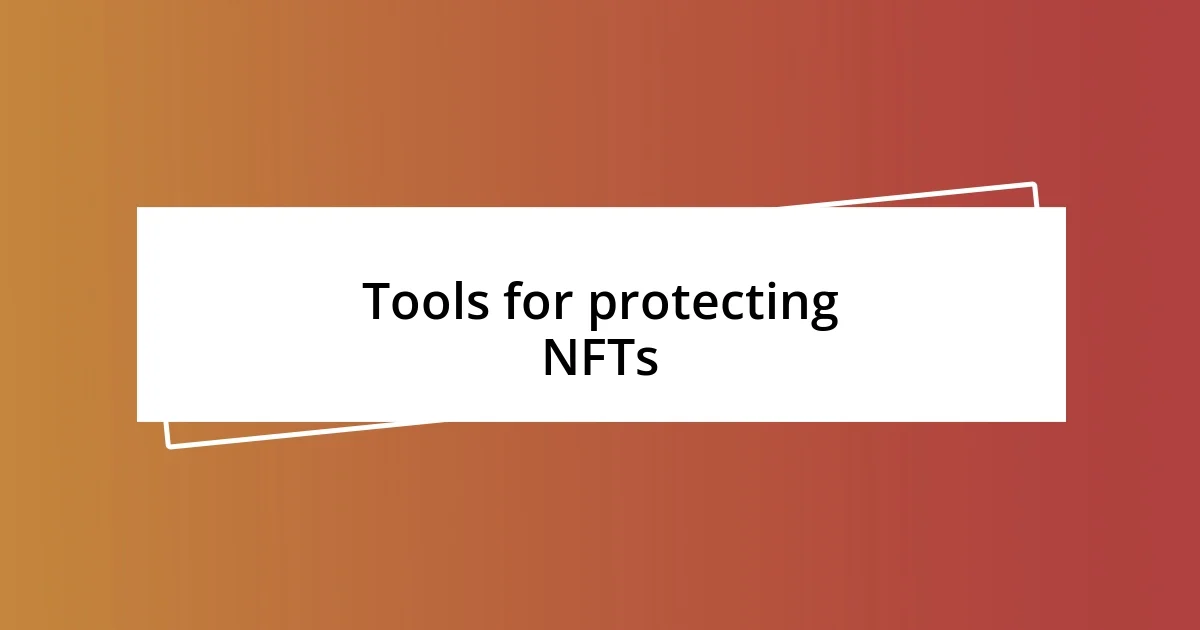
Tools for protecting NFTs
When it comes to protecting NFTs, utilizing robust tools can make all the difference. For instance, I often lean on two-factor authentication (2FA) whenever I access my wallets or NFT platforms. It’s a simple yet effective layer of security that’s saved me from potential breaches. Living in the digital world, have you ever thought about how easily one forgets this critical step? I remember a close call where I almost clicked on a login link without 2FA; it was a wake-up moment for me.
I also value the role of reputable NFT marketplaces and their built-in security features. A few months ago, I signed up with a platform that incorporates advanced encryption techniques, and honestly, it felt like a breath of fresh air. Knowing your environment is secure adds a level of comfort that’s hard to replicate. Have you ever considered how the choice of platform influences your NFT security? My experience has shown that choosing trustworthy places to buy or sell can greatly reduce risks.
Lastly, let’s talk about the power of community and resources. I often find myself engaging in discussions on forums, learning from others’ experiences, and sharing my own. The invaluable insights gained from the community have guided my decisions and sometimes even led me to avoid costly mistakes. Have you ever wondered how collective knowledge can elevate your understanding of NFT safety? That sense of shared wisdom has truly transformed my approach to security, making me feel more connected and empowered in this digital landscape.
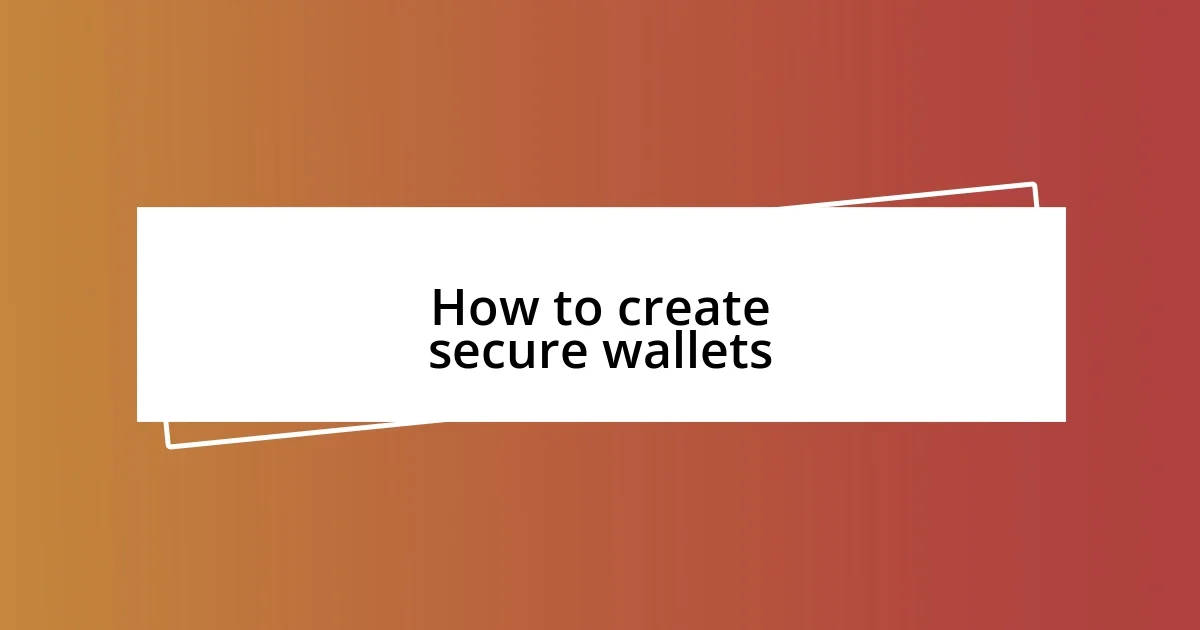
How to create secure wallets
Creating a secure wallet is paramount for any NFT enthusiast. I’ve discovered that picking a hardware wallet involves looking beyond just brand names. For me, it was about finding one that felt right in my hands and had a reputation for reliability. I remember the excitement of setting up my first hardware wallet; it felt like preparing for a big adventure, knowing I was taking tangible steps to safeguard my assets.
It’s crucial to pay attention to the wallet’s recovery process. I’ve had moments where I hesitated to record my recovery phrase, thinking I could just remember it. That’s a risky gamble! Now, I write it down and store it in separate locations, almost like a treasure map that leads back to my digital assets. Have you ever noticed how small oversights can lead to larger headaches? Your recovery process needs to be foolproof.
Additionally, I always emphasize the importance of privacy when creating wallets. I recall a time where I openly shared details about my newest investments, thinking it was just casual conversation. It didn’t take long for me to realize that sharing too much can make you a target. So now, I keep such discussions private, treating my digital assets like delicate secrets that only get revealed to those who truly understand their value. In this evolving space, discretion has become one of my strongest allies in securing my NFTs.
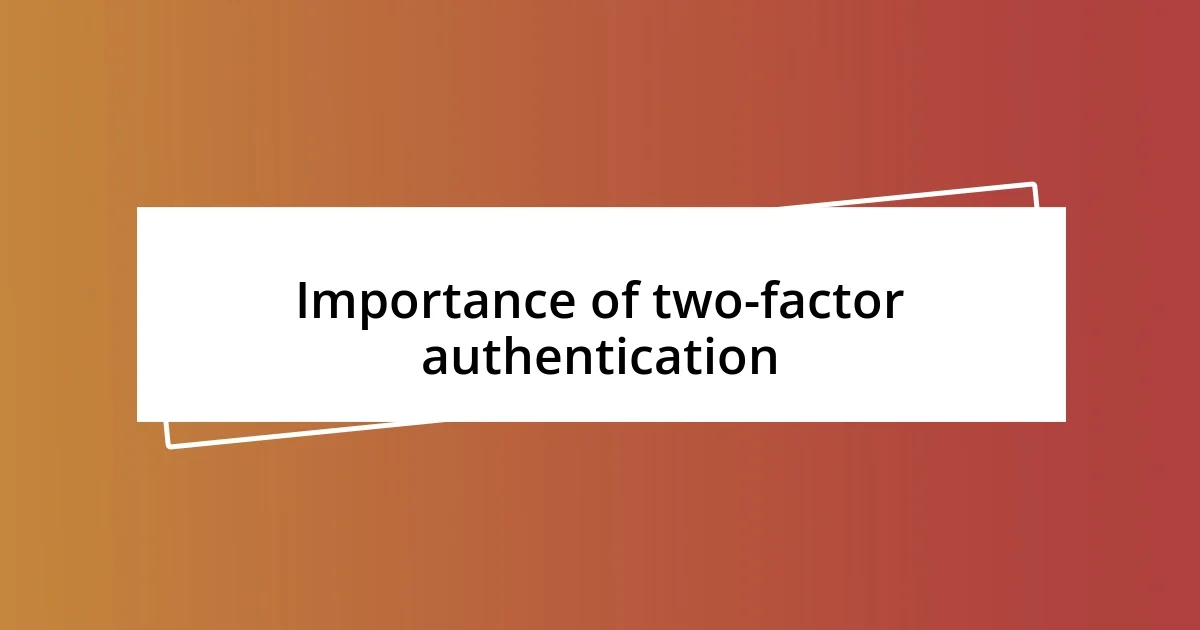
Importance of two-factor authentication
Utilizing two-factor authentication (2FA) in my NFT security practices is something I hold in high regard. Just the other day, I had to log into my wallet and it reminded me how much I appreciate that extra verification step. It’s not just a number; it’s peace of mind. Have you ever experienced that brief moment of anxiety before entering a code? It’s a reassuring process that turns what could be a blind leap into a calculated step.
In my experience, the act of enabling 2FA has repeatedly shown me how vulnerable our digital lives can be. I recall a friend who suffered a significant loss because they overlooked this crucial layer. Watching them go through that was eye-opening; it made me realize how easily things can spiral out of control if you skip even a simple security measure. Can you imagine losing your hard-earned NFTs just because you thought a quick login wouldn’t hurt? It’s a lesson that lingers in my mind every time I input those codes.
Moreover, I’ve found that 2FA isn’t just about protecting my assets; it also cultivates a responsible mindset towards my digital activities. Engaging in the habit of authenticating my identity makes me more aware of potential risks. I remember the first time I received a notification asking for a code sent to my phone; it felt like I had an invisible shield around my assets. When was the last time you checked your security measures? Taking these steps isn’t just smart; it’s essential for anyone serious about safeguarding their NFTs in a world where vigilance often makes the difference between safety and loss.
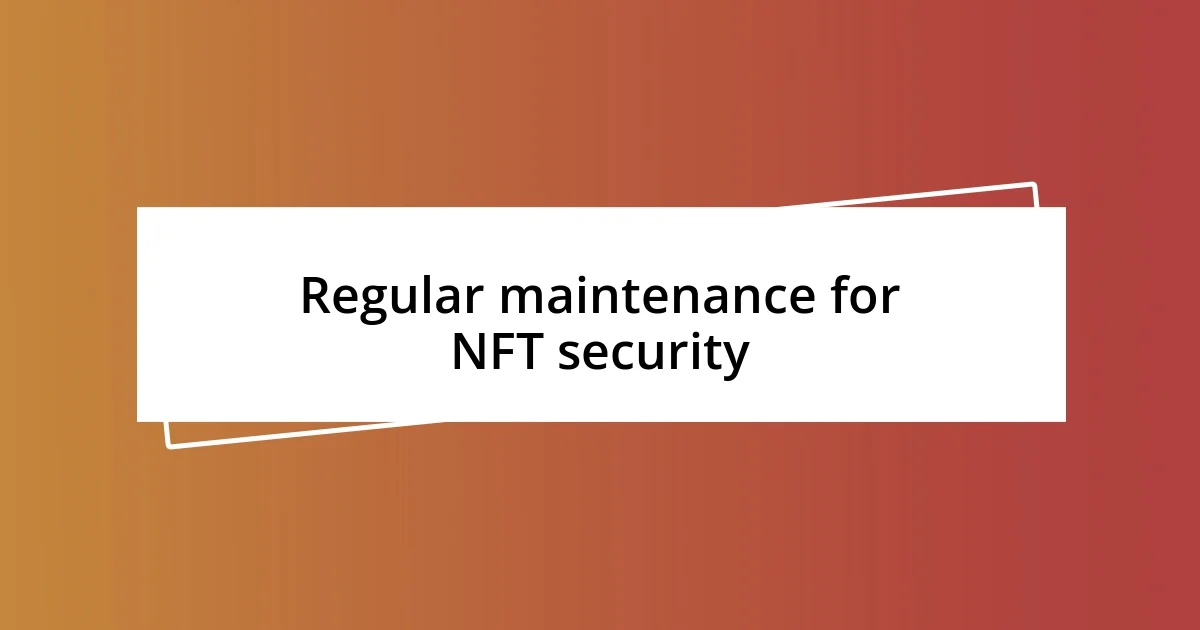
Regular maintenance for NFT security
Maintaining security for my NFTs requires more than just setting up a wallet; it’s about consistent vigilance. Each month, I set a date to review my digital environments, ensuring that software updates are applied and security protocols are intact. Have you ever felt that exhilarating sense of control when everything aligns just right? That’s what I experience knowing my assets are secured and up-to-date.
I can’t stress enough the importance of periodically changing my passwords. Recently, I underwent a password overhaul, and it felt liberating! I used to think one strong password was enough, but I quickly learned how even slight complacency can open the door to risk. It’s almost like cleaning out a cluttered closet; it’s refreshing and essential to maintaining a secure space. What about you? When was the last time you evaluated your password strategy?
Another aspect I always prioritize is documenting any potential security breaches. There was that time when I noticed an unusual login attempt; I’d never felt that pang of panic rush through me. I realized that recording such incidents—not just ignoring them—helps build a clearer picture of potential vulnerabilities. It’s part of being proactive rather than reactive. Remind yourself, maintaining NFT security is an ongoing journey, not a one-time task. How often do you check in on your security practices?












